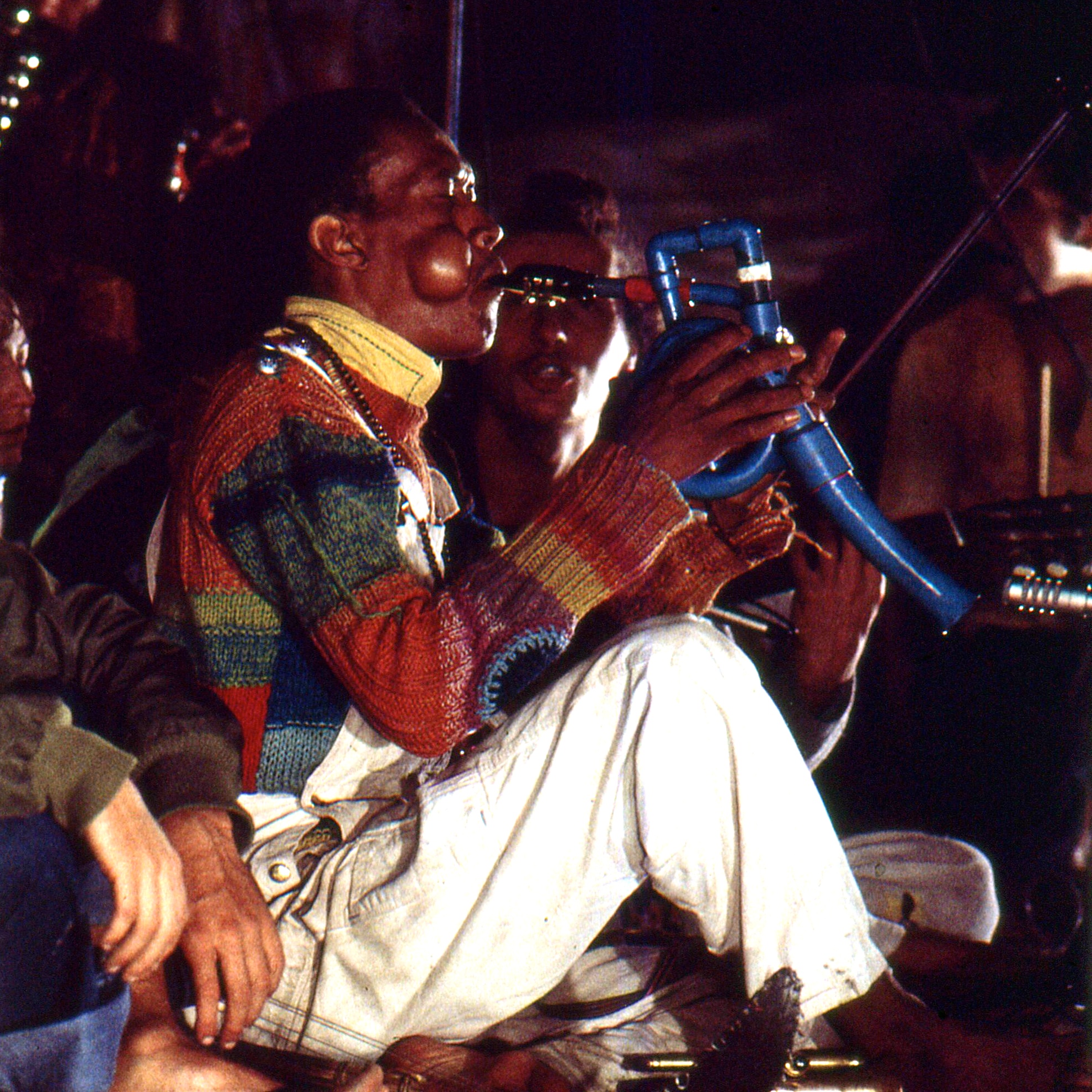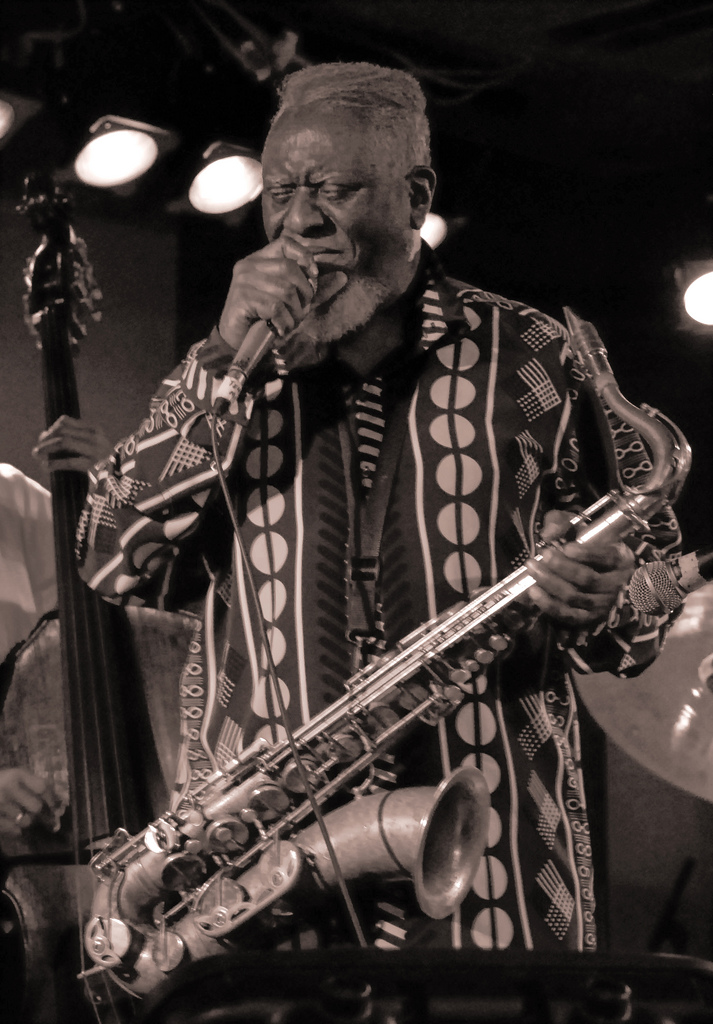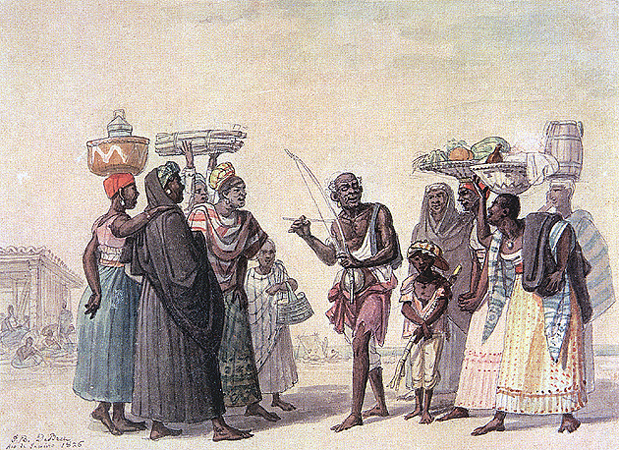|
Om Shanti Om (album)
''Om Shanti Om'' is a live album by multi-instrumentalist Don Cherry. It was recorded in 1976 at RAI Studios in Rome, Italy, for television broadcast, and was released in 2020 by Black Sweat Records. On the album, Cherry is heard on pocket trumpet, ngoni, kora, and flute, and is joined by Naná Vasconcelos on berimbau, Gian Piero Pramaggiore on guitar, and his wife Moki Cherry on tambura. Reception In a review for ''Jazzwise'', Edwin Pouncey wrote that, on the album, "the hard-edged urban blast of 1960s modern jazz is replaced with a more meditational organic music groove where the assembled players become sonically entwined. Here vocal chant and percussion are utilised to form densely patterned layers of undulating rhythm." A writer for ''Komakino'' described the album as "a blissful compendium of mesmeric vibes, spiritually retuning your innermost self," and commented: "I reached the needed inner consciousness." Author Daniel B. Sharp remarked: "Although this music has move ... [...More Info...] [...Related Items...] OR: [Wikipedia] [Google] [Baidu] |
Don Cherry (trumpeter)
Donald Eugene Cherry (November 18, 1936 – October 19, 1995) was an American jazz trumpeter, bandleader, and multi-instrumentalist. Beginning in the late 1950s, he had a long tenure performing in the bands of saxophonist Ornette Coleman, including on the pioneering free jazz albums '' The Shape of Jazz to Come'' (1959) and '' Free Jazz: A Collective Improvisation'' (1961). Cherry also collaborated separately with musicians including John Coltrane, Charlie Haden, Sun Ra, Ed Blackwell, the New York Contemporary Five, and Albert Ayler. Cherry released his debut album as bandleader, '' Complete Communion'', in 1966. In the 1970s, he became a pioneer in world music, with his work drawing on African, Middle Eastern, and Hindustani music, as heard on the 1975 release ''Brown Rice''. He was a member of the ECM group Codona, along with percussionist Naná Vasconcelos and sitar and tabla player Collin Walcott. Chris Kelsey of AllMusic called Cherry "one of the most influential jazz mu ... [...More Info...] [...Related Items...] OR: [Wikipedia] [Google] [Baidu] |
Free Jazz
Free jazz, or free form in the early to mid-1970s, is a style of avant-garde jazz or an experimental approach to jazz improvisation that developed in the late 1950s and early 1960s, when musicians attempted to change or break down jazz conventions, such as regular tempos, Musical tone, tones, and chord changes. Musicians during this period believed that the bebop and modal jazz that had been played before them was too limiting, and became preoccupied with creating something new. The term "free jazz" was drawn from the 1960 Ornette Coleman recording ''Free Jazz: A Collective Improvisation''. Europeans tend to favor the term "free improvisation". Others have used "modern jazz", "creative music", and "art music". The ambiguity of free jazz presents problems of definition. Although it is usually played by small groups or individuals, free jazz big band, big bands have existed. Although musicians and critics claim it is innovative and forward-looking, it draws on early styles of jazz ... [...More Info...] [...Related Items...] OR: [Wikipedia] [Google] [Baidu] |
Ngoni (instrument)
The ngoni (also written ''ngɔni'', ''n'goni'', or ''nkoni'') is a traditional West African string instrument. Its body is made of wood or calabash with dried animal (often goat) skin head stretched over it. The ngoni, which can produce fast melodies, appears to be closely related to the '' akonting'' and the '' xalam''. This is called a ''jeli ngoni'' as it is played by griots at celebrations and special occasions in traditional songs called ''fasa''s in Mandingo. Another larger type, believed to have originated among the donso (a hunter and storyteller caste of the Wassoulou cultural region) is called the ''donso ngoni''. This is still largely reserved for ceremonial purposes. The donso ngoni, or "hunter's harp," has six strings. It is often accompanies singing along with the '' karagnan'', a serrated metal tube scraped with a metal stick. The donso ngoni was mentioned by Richard Jobson in the 1620s, describing it as the most commonly used instrument in the Gambia. He describe ... [...More Info...] [...Related Items...] OR: [Wikipedia] [Google] [Baidu] |
Kora (instrument)
The kora (Manding languages: ''kɔra'') is a stringed instrument used extensively in West Africa. A kora typically has 21 strings, which are played by plucking with the fingers. It has features of the lute and harp. Description The kora is built from a gourd, cut in half and covered with cow skin to make a resonator with a long hardwood neck. The skin is supported by two handles that run underneath it. It has 21 strings, each of which plays a different note. These strings are supported by a notched, double free-standing bridge. The kora doesn't fit into any one category of musical instrument, but rather several, and must be classified as a "double-bridge-harp-lute." The strings run in two divided ranks, characteristic of a double harp. They do not end in a soundboard but are instead held in notches on a bridge, classifying it as a bridge harp. The strings originate from a string arm or neck and cross a bridge directly supported by a resonating chamber, also making it a lute. ... [...More Info...] [...Related Items...] OR: [Wikipedia] [Google] [Baidu] |
Naná Vasconcelos
Juvenal de Holanda Vasconcelos, known as Naná Vasconcelos (2 August 1944 – 9 March 2016), was a Brazilian percussionist, vocalist and berimbau player, notable for his work as a solo artist on over two dozen albums, and as a backing musician with Pat Metheny, Don Cherry, Jan Garbarek, Egberto Gismonti, Gato Barbieri, and Milton Nascimento. Life and career Vasconcelos was born in Recife, Brazil. Beginning from 1967 he joined many artists' works as a percussionist. Among his many collaborations, he contributed to four Jon Hassell albums from 1976 to 1980 (including '' Possible Musics'' by Brian Eno and Hassell), and later to several Pat Metheny Group works and Jan Garbarek concerts from early 1980s to early 1990s. In 1984 he appeared on the Pierre Favre album ''Singing Drums'' along with Paul Motian. He also appears on Arild Andersen's album ''If You Look Far Enough'' with Ralph Towner. He formed a group named Codona with Don Cherry and Collin Walcott, which released three ... [...More Info...] [...Related Items...] OR: [Wikipedia] [Google] [Baidu] |
Berimbau
The berimbau (, borrowed from Kimbundu ''mbirimbau'') is a traditional Angolan musical bow that is commonly used in Brazil. It is also known as ''sekitulege'' among the Baganda and Busoga. It consists of a single-stringed bow attached to a gourd resonator and is played with a stick and a coin or stone to create different tones and rhythms. The berimbau was used in many parts of Africa and Brazil during the 19th century to accompany chants and storytelling. It is part of the candomblé tradition, later incorporated into the Afro-Brazilians, Afro-Brazilian art capoeira. Until the mid-20th century, it was used almost exclusively within the black community, but after the popularization of capoeira, it gain wider popularity. Today, berimbau is used in various genres of popular music. History Berimbau is an adaptation of African gourde musical bows, as no Indigenous peoples in Brazil, Indigenous Brazilian or European people use musical bows. According to the musicologist Gerard K ... [...More Info...] [...Related Items...] OR: [Wikipedia] [Google] [Baidu] |
Moki Cherry
Moki Cherry (born Monika Marianne Karlsson; 8 February 1943 – 29 August 2009) was a Swedish interdisciplinary artist and designer who worked in textiles, fashion design, woodworks, painting, collage, ceramics, and set design. Her practice traversed the worlds of art, music, and theater with diverse influences such as Indian art and music, Tibetan Buddhism, fashion, traditional folk arts and dress, abstraction, cartoons, and pop art. From 1977 she split her time living between Tågarp, Sweden and Long Island City in New York. Moki collaborated with her husband, the American jazz trumpeter, Don Cherry, throughout her lifetime – they performed in concerts as Organic Music, where her artworks were also displayed, and ran workshops for children. Her designs also appeared on Don's album covers and as costumes worn by him in concert. Early life Moki Cherry was born Monika Marianne Karlsson on 8 February 1943 in Koler in Norrbotten, Sweden. Her father, Verner Karlsson, ran the stat ... [...More Info...] [...Related Items...] OR: [Wikipedia] [Google] [Baidu] |
Tanpura
The tanpura (; also referred to as tambura, tanpuri, tamboura, or tanpoura) is a long-necked, plucked, four-stringed instrument originating in the Indian subcontinent, found in various forms in Indian music. Visually, the tanpura resembles a simplified sitar or similar lute-like instrument, and is likewise crafted out of a gourd or pumpkin. The tanpura does not play a melody, but rather creates a meditative ambience, supporting and sustaining the performance of another musician or vocalist, as well as for musicians accompanying a dance performance. The instrument's four strings are tuned to specific notes of a given scale or musical key, normally the fifth (''Pa''; Solfège, “So”) and the root tonic (''Sa''; “Do”). The strings are generally tuned 5-8-8-1. One of the three strings tuned to the tonic is thus an octave below the others, adding greater resonance and depth to the ambient drone. Through continuous, rhythmic plucking of its strings, the tanpura creates ... [...More Info...] [...Related Items...] OR: [Wikipedia] [Google] [Baidu] |
Jazzwise
''Jazzwise'' is a British monthly magazine focused on jazz, launched in 1997. The magazine covers a range of jazz sub-genres and provides news coverage, a national gig guide, a jazz-on-film page, feature articles, and a review section that evaluates new musical releases, DVDs, books, and live performances. News stories also feature on the ''Jazzwise'' magazine website. ''Jazzwise'' instructs new jazz writers through its ongoing intern scheme and '' The Write Stuff'' workshops held each November during the London Jazz Festival. Awards In 2006, ''Jazzwise'' editor Jon Newey won Journalist of the Year at the Parliamentary Jazz Awards. In 2007, ''Jazzwise'' won two awards – Best Jazz Publication at the Parliamentary Jazz Awards and Best Jazz Publication at the Ronnie Scott's awards. In 2009, ''Jazzwise'' writer Kevin Le Gendre won Journalist of the Year at the Parliamentary Jazz Awards. In 2010, ''Jazzwise'' won Best Jazz Publication for the second time, gig guide editor Mi ... [...More Info...] [...Related Items...] OR: [Wikipedia] [Google] [Baidu] |
Tom Hull – On The Web
Tom Hull is an American music critic, web designer, and former software developer. Hull began writing criticism for ''The Village Voice'' in the mid 1970s under the mentorship of its music editor Robert Christgau, but left the field to pursue a career in software design and engineering during the 1980s and 1990s, which earned him the majority of his life's income. In the 2000s, he returned to music reviewing and wrote a jazz column for ''The Village Voice'' in the manner of Christgau's "Consumer Guide", alongside contributions to ''Seattle Weekly'', '' The New Rolling Stone Album Guide'', NPR Music, and the webzine ''Static Multimedia''. Hull's jazz-focused database and blog ''Tom Hull – on the Web'' hosts his reviews and information on albums he has surveyed, as well as writings on books, politics, and movies. It shares a functional, low-graphic design with Christgau's website, which Hull also created and maintains as its webmaster. Education Hull attended Wichita State ... [...More Info...] [...Related Items...] OR: [Wikipedia] [Google] [Baidu] |




